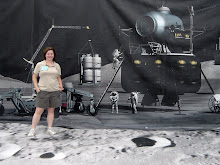This week, the Committee for the Scientific Context for Exploration of the Moon had our third meeting. What we’re charged to do is to consider the science that can and should be done in the new Vision for Exploration at NASA, which begins with new missions, both robotic and human, to the Moon. In some ways, it’s an easy task, because we haven’t landed on the Moon in 35 years, so many of the scientific questions we had after Apollo are still outstanding. In other ways, it’s a difficult task, because our understanding of all the planets has evolved so much since then, and we need to reconsider how the Moon fits into the solar system and in what ways it is unique. The Moon’s combination of unique science and accessibility make it a really exciting place to talk about and I really enjoy being in a room full of 15 people all jazzed about the Moon!
Some of the fundamental science that we can do at the moon is near and dear to me. We know that large impact craters are ubiquitous on planetary surfaces. One rather small crater on Earth, the Chicxulub crater in Mexico, was largely responsible for wreaking havoc with the Earth’s climate and food chain, triggering a mass extinction of many species on Earth, including the dinosaurs. When you look up at the Moon, the large dark patches are lava flows filling giant impact craters. These craters are 1000 km across and formed in collisions with thousands or millions of times as much energy as the collision that created Chicxulub. To an incoming asteroid or comet, the Earth and Moon appear as a system with a single center of gravity, so whatever hits the Moon has an equal or greater chance of hitting the Earth. So it’s logical that if the Moon experienced these huge collisions, the Earth did too. But where is the evidence on the Earth?
The largest craters on the Moon are very old (4 billion years or more) and they reside in a crust that is 4.5 billion years old. In contrast, the Earth recycles its surface all the time, through erosion, burial, mountain building and subduction. Very few rocks on the Earth are older than 3.5 billion years, and the oldest recognized rocks are a bit of outcrop in northwestern Canada at just about 4 billion years. There are certainly not enough rocks to recognize giant old impact craters at 4 billion years on the Earth. And yet, it was at this time that life was just getting started on Earth. If one medium-sized crater killed more than half the flourishing species in the Cretaceous, what would a hundred giant impacts do to primitive life on Earth?
Some of the outstanding questions about the effects on Earth have to do with how many impacts, how big, and how closely spaced in time. We can’t figure that out on the Earth, because we don’t have the rocks that recorded that information. But the Moon preserves all the evidence if we can just get there and look for it. Moon rocks tell us the timing of large impact events, when and how many, and can even tell us what made the impact, what kind of meteorite. And just like pieces of the Moon get knocked off onto the Earth, large impacts should knock pieces of the Earth onto the Moon, and we might be able to find some very ancient Earth rocks on the Moon (though they will be exceedingly hard to find).
Other way cool science at the Moon has to do with the Moon’s unique atmosphere, which is a combination of outgassing from the planet, solar wind interactions with the surface, and levitating dust; the environment at the lunar poles, where permanently-lit peaks might be good places for solar panels and permanently dark craters might act as cold traps that store volatiles like water; and deploying a network of monitoring stations that can measure moonquakes, the magnetic field, and heat flow from the Moon. It’s also neat to think about the opportunities for new robotic capabilities – with a round-trip communications time of less than 5 seconds, we’ll have a chance to explore as scientists on the Earth interacting with robots on the surface.
Subscribe to:
Post Comments (Atom)

No comments:
Post a Comment